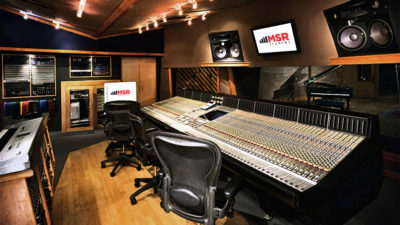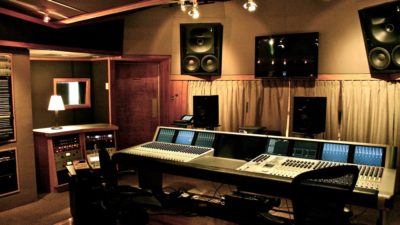Midtown Meltdown: MSR Studios is Shutting Down
Just as summer begins, a major Midtown recording studio has reached the end of the road: MSR Studios is closing its doors at the end of June.
Ultimately, this 14,000 sq. ft. heavy hitter couldn’t escape the unkind realities of doing business in New York City’s famed Times Square neighborhood. Pile on the ever-increasing pressures that an evolving music industry has placed on big rooms everywhere, and its collapse is, unfortunately, understandable.
Marked for Mayhem
For decades, the location of MSR Studios on 168 W. 48th St., between 6th and 7th Avenues, was a major asset. The lullaby of Broadway has always been right around the corner, just as it was when the facility was launched as Right Track Recording in 1976 by Simon Andrews. Being smack in the middle of “The Crossroads of the World” carried a glamorous cache that was appealing to rock stars, producers, cast albums, and much more.
Flash forward almost three decades, and in 2005 Andrews partnered up with Dave Amlen, who merged his Sound On Sound Recording with Right Track to form Legacy Recording Studios. The partnership dissolved in late 2008, and in 2009 Amlen went on to found Manhattan Sound Recording (MSR), acquiring Legacy’s two tracking rooms and its large format mix room. Upgrades at the time included a cosmetic renovation of the facilities, along with a complete technical overhaul of its B Room, which had formerly been owned and operated by renowned engineer Frank Filipetti.
Technical excellence inside the studios were never an issue. Studio A is MSR’s largest tracking room – and one of the largest available in New York City – complemented by a 72-input SSL J Series console, plus a custom Augspurger main monitoring system with custom Leigh Audio 18” subwoofers designed by MSR Chief Engineer Brad Leigh. Studio B is built around a Euphonix System 5 console, making it perfect to handle the high track counts of the many Broadway cast albums tracked in Studio A. Meanwhile, Studio C hosted a second 72-input SSL J Series desk, which anointed it MSR’s elite mix room.
Conditions outside the facility, however, were another matter entirely. The renewal that is a defining characteristic of Manhattan struck hard in MSR’s backyard, with major construction projects erupting all around the studio. The former 701 7th Avenue – which had housed Unique Recording Studios among others – had been physically connected to MSR before it was dismantled and then built up again as a Marriot Hotel addition throughout 2014 and 2015 (the project will be completed in 2017). “Every time they took out a drill, we could hear it in Studio A and Studio B,” Amlen says.
MSR and its clients gamely weathered that project, and started to experience a resurgence of recording and mixing in spring of this year. But when Amlen, Leigh and MSR Studio Manager Scott Kubrin were informed that half of 48th Street adjacent to the studio was about to be torn down and rebuilt, along with a new skyscraper set to be erected directly across the street, the end of MSR was inevitable. Just adding to the chaos is the fact that the former Smilers building on the corner of 48th and 7th, adjacent to MSR and abutting the live room of Studio C is under construction and will house an 18-story billboard atop a tall four-story building designed for restaurant and retail.

The live room in Studio A couldn’t be fully isolated from the nonstop construction outside the facility.
“It’s hard to record an orchestra when you have a jackhammer going in the background,” observes Amlen. “We had just gotten through that scenario, and to go through the whole thing all over again for three years was untenable. I’ve commiserated with other studio owners and they say, ‘You’re in a war zone, and it’s only going to get worse. I don’t know how people will come and work with you when there are scaffolds all around you.’ We’ve had clients leave because of conditions on the street, regardless of what’s going on inside the facility.”
Although MSR’s lease was due to run through the end of 2019, Amlen was able to amicably negotiate an early exit. The last day of sessions at MSR will take place on June 30th.
Environmental Impact
The void from a recording and mixing standpoint is significant, depriving New York City first and foremost of one of its largest professional tracking rooms. Measuring 40’ x 40’ x 15’, MSR’s Studio A was sufficiently spacious to record dozens of Broadway cast albums like the recent sessions for Fiddler on the Roof, and the 2016 Grammy-nominated Something Rotten! (Best Musical Theater Album). Beyonce, Mariah Carey, J Cole, Phil Collins, J. Geils, Whitney Houston, Elton John, Madonna, Metallica, The Spiderman Soundtrack with Bono and the Edge, are just a few of the many other elite artists/productions to work at MSR.
Avatar, Manhattan Center, and more recently the DiMenna Center all have the square footage and skillset to do large-scale recordings. But a sudden 25% reduction in available facilities doesn’t reflect well on a metro area trying to affirm itself as an attractive recording option in light of initiatives like the Empire State Post Production Tax Credit, and now the pending Empire State Music Production Tax Credit.
In addition to depriving clients of an option, the loss of MSR also terminates employment for audio professionals. About to become jobless are 12 full-time employees, plus another approximately half-dozen freelancers that MSR employs on a regular basis. As Amlen notes, their re-absorption into other NYC facilities – or even an uptick of work for other local studios – is not a given.
“Years back, when Sony Studios closed [in 2007] everybody said, ‘There’s going to be an influx of business (for everyone else in NYC),’” Amlen recalls. “But the reality was that the writers and producers around Sony moved to Atlanta, Nashville, Miami and LA. So the work didn’t come in droves. The closing of MSR won’t have that kind of effect – we’re not a talent factory like Sony was – but the sad thing is that there’s less choices for active recording musicians. There will be another choice, but just not tomorrow.”
Next Steps
That other choice Amlen is alluding to is his next step. After he decommissions the current space, the plan is to relocate and reopen, either as MSR or under a more classic name.
“This is just a temporary hiatus,” Amlen affirms. “The new studio may be MSR, but I may resurrect Sound on Sound. I’m trying to shake things up a bit. That was my baby and it may be time for it to come back. But things change, and the relocated rejuvenated place will be a more modern take on what we’re doing now, and rates will reflect that as well.”
Amlen’s new take on rates will reflect a flexibility that he didn’t have with 14,000 sq. ft. to cover on a monthly basis. And as brutal as the last few years have been, he fully expects the rebirth to be in the Big Apple.
“The overall sentiment is that you have to be on this island,” he says of his elite clientele. “It’s still important to them to work here. Manhattan is geographically still a hub where everybody comes and goes from, because you’re at the center of where everything can happen.”
- David Weiss
Please note: When you buy products through links on this page, we may earn an affiliate commission.









William A. Rhinehart
June 21, 2016 at 11:34 pm (8 years ago)I remember recording at Right Track and Unique back in the mid and late 80’s Womderful music was made in those rooms and I wonder how much the state
of digital recording and not construction had to do with the demise of the studios.
Albert Ross
June 22, 2016 at 10:22 am (8 years ago)A nice spot to work for a few years…went to the Eric ‘Simon’ Andrews Memorial but didn’t stay.
Gotta keep keepin’ on.
sonicscoop
June 22, 2016 at 11:07 am (8 years ago)Thanks Albert — Frank Filipetti’s tribute to Simon gives more of the original history of the space — see this post in a Pro Recording Workshop forum, by way of Chuck Zwicky: http://prorecordingworkshop.lefora.com/reply/46950897/RIP-Simon-Andrews#.V2qnbqLnSJ0
malcolmpollack
June 22, 2016 at 6:11 pm (8 years ago)So sorry to hear this, even though we knew it would come. Thank you David for providing us with decades of outstanding places to make music. Looking forward to your next venture!
TheRealNYC
June 23, 2016 at 2:43 am (8 years ago)Utterly disappointing that Manhattan continues to be under siege by developers. They are out of control, causing so many problems, with no benefit to the people who live and work here.
djsmps
June 24, 2016 at 4:52 pm (8 years ago)I’m sorry to hear this. The big studios are disappearing. An editorial note: You wrote ” Being smack in the middle of “The Crossroads of the World” carried a glamorous cache that was appealing to rock stars…” The word is “cachet”, not “cache”.
Aristedes P DuVal
June 24, 2016 at 6:02 pm (8 years ago)I don’t think I’ve ever been in MSR or Sound on Sound- maybe when it was Right Track years ago? Sad to hear of all this DESTRUCTion abounding. I want to see the studio intact before it goes! Will there be a closing party? Could i still book a session? MR. MELODY TM
Stu
June 27, 2016 at 1:25 am (8 years ago)More of the great New York studios just fading away into obscurity. I fear that the up-and-coming generations will forget or never even know that New York was once the hotbed for American music, and that the entire music world looked to New York for this very reason.
ApathyNihilism
August 31, 2016 at 3:28 pm (8 years ago)Awful. NYC should also ban the oversized advertising. It’s a horrible eyesore, essentially legalized graffiti and vandalism.